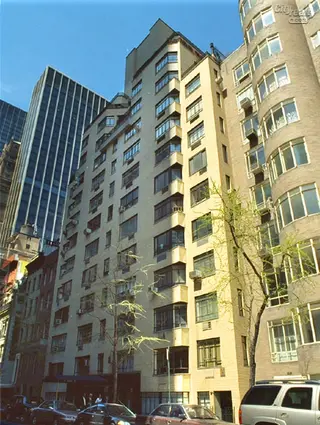 Carter Horsley
Carter HorsleyDec 23, 2011
Carter's Review
This 15-story prewar, Art Deco cooperative apartment building was built in 1939 by Nathaniel Wallenstein, who also developed the handsome apartment buildings at 411 West End Avenue and 19 East 88th Street.
The pale-yellow brick building, which is known as Regent House, has 73 apartments.
It has a doorman, laundry room, roof deck, and garden as well as a canopied entrance and a black marble entrance surround.
Apartments have sunken living rooms.
The building has a few terraces and corner many corner windows and some protruding air-conditioners but no balconies and no sidewalk landscaping.
It is one of three mid-rise apartment buildings with light-colored façades on the same side of the street facing the walled garden of the Museum of Modern Art.
It has a very central midtown location, just a few blocks north of Rockefeller Center and a few blocks south of Tiffany's, F.A.O. Schwartz and Bergdorf Goodman.
There is good bus service in the area and a subway station is one block south.
In his March 12, 2006 "Streetscapes" column in The New York Times, Christopher Gray provided the following commentary of the developer:
"Not many developers had the courage to build tall in the middle of the Depression, but Nathaniel Wallenstein put up two at the same time, one on 88th Street and one at 411 West End Avenue, at 80th Street. Together they play a modernistic, long-range duet within a matrix of 1910's-1920's neighborhoods....In 1935, he began these two much-more-ambitious projects on opposite sides of Central Park. At 80th and West End, he had the veteran architect George F. Pelham design a 20-story building, its cream-colored façade relieved by casement windows, some wrapping around the corners because of newly developed cantilever construction methods. But what makes pedestrians pause and look up are the flowing stainless steel bands running across the top and dripping down the front like a metallic waterfall."
"Developers had new ideas about interiors, too," the article continued, "and ads for 411 West End Avenue specifically mentioned sunken living rooms, colored tile in the bathrooms, Venetian blinds, glass-enclosed tubs - and 'stall showers in every bathroom,' according to an advertisement in The New York Times in April 1936. A five-room apartment had a circular entrance gallery, and there were duplex apartments with terraces on the setbacks of the building."
"The 411 West End building opened in 1936," the article said, "the same year that Wallenstein completed 19 East 88th Street, in a completely different vocabulary and designed by William Dowling. The Times said that both 411 West End and 19 East 88th were 'hailed by builders and realty interests as an omen of recovery.' The Wallenstein project at 88th and Madison had interiors similar to those at 411 West End Avenue - advertisements for both boasted air-conditioner electrical outlets - but it also had a noticeably different take on Art Deco. Unlike 411 West End, which is purely vertical, the 88th Street building is an unresolved 16-story battle. Horizontal forms of dark- and light-brick bands tussle with the centrally placed vertical bays of windows. But there is more to look at here than 411's single trick in stainless steel. At 19 East 88th Street, the horizontal terrace grilles on the topmost floors race around the balconies like zipper lights, their curved corners suggesting streamlined ocean liner design. There are several patches of patterned brick, like the huge sawtooth-pattern panels near the top. And, in the rear, there are two flying buttresses, which are not used for the sake of the structure - as in supporting the sidewalls of a medieval cathedral - but to enclose vent or plumbing chases as they go up the outside wall and jump in midair across two terraced setbacks."
"...The next project on which Dowling and Wallenstein collaborated was another apartment house, at 25 West 54th Street, which was completed in 1939. Like its precursors, it uses cream-colored brick, but there are no stainless steel strips, no sawtooth brick, no flying buttresses - it is just a plain-vanilla box."
Yes, but it is now surrounded by elegant hotels and major office buildings and, furthermore, the fact that its wings are slightly setback and that its 11th and 12th floors are chamfered with a central indentation makes its proportions quite pleasant. . It doesn't hurt, either, that it is just to the west of the through-block Rockefeller Apartments, which has large cylindrical bay windows.

- Co-op built in 1939
- Located in Midtown West
- 65 total apartments 65 total apartments
- 10 recent sales ($560K to $1.7M)
- Doorman
- Pets Allowed

 6sqft delivers the latest on real estate, architecture, and design, straight from New York City.
6sqft delivers the latest on real estate, architecture, and design, straight from New York City.
